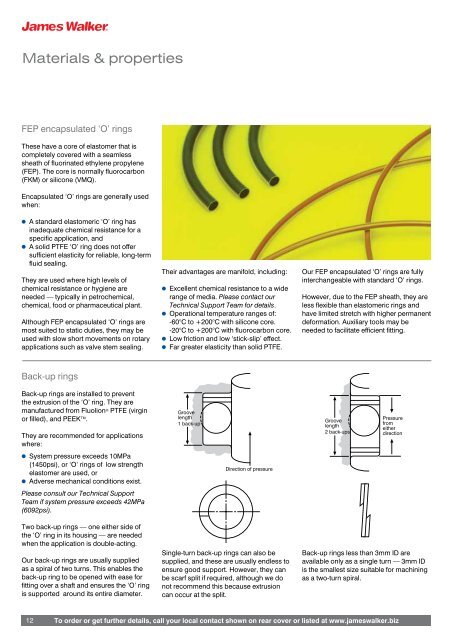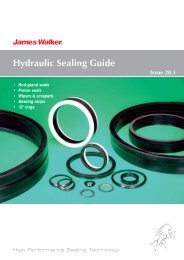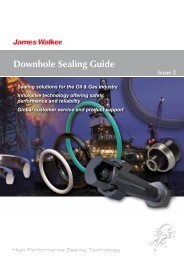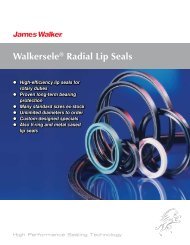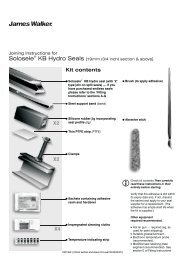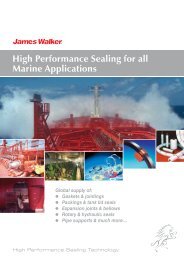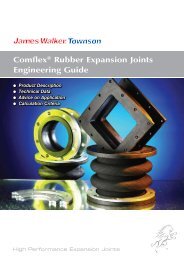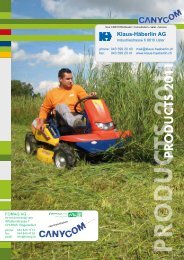'O' Ring Guide
'O' Ring Guide
'O' Ring Guide
Create successful ePaper yourself
Turn your PDF publications into a flip-book with our unique Google optimized e-Paper software.
Materials & properties<br />
FEP encapsulated ‘O’ rings<br />
These have a core of elastomer that is<br />
completely covered with a seamless<br />
sheath of fluorinated ethylene propylene<br />
(FEP). The core is normally fluorocarbon<br />
(FKM) or silicone (VMQ).<br />
Encapsulated ‘O’ rings are generally used<br />
when:<br />
l A standard elastomeric ‘O’ ring has<br />
inadequate chemical resistance for a<br />
specific application, and<br />
l A solid PTFE ‘O’ ring does not offer<br />
sufficient elasticity for reliable, long-term<br />
fluid sealing.<br />
They are used where high levels of<br />
chemical resistance or hygiene are<br />
needed — typically in petrochemical,<br />
chemical, food or pharmaceutical plant.<br />
Although FEP encapsulated ‘O’ rings are<br />
most suited to static duties, they may be<br />
used with slow short movements on rotary<br />
applications such as valve stem sealing.<br />
Their advantages are manifold, including:<br />
l Excellent chemical resistance to a wide<br />
range of media. Please contact our<br />
Technical Support Team for details.<br />
l Operational temperature ranges of:<br />
-60°C to +200°C with silicone core.<br />
-20°C to +200°C with fluorocarbon core.<br />
l Low friction and low ‘stick-slip’ effect.<br />
l Far greater elasticity than solid PTFE.<br />
Our FEP encapsulated ‘O’ rings are fully<br />
interchangeable with standard ‘O’ rings.<br />
However, due to the FEP sheath, they are<br />
less flexible than elastomeric rings and<br />
have limited stretch with higher permanent<br />
deformation. Auxiliary tools may be<br />
needed to facilitate efficient fitting.<br />
Back-up rings<br />
Back-up rings are installed to prevent<br />
the extrusion of the ‘O’ ring. They are<br />
manufactured from Fluolion ® PTFE (virgin<br />
or filled), and PEEK TM .<br />
They are recommended for applications<br />
where:<br />
Groove<br />
length<br />
1 back-up<br />
Groove<br />
length<br />
1 back-up<br />
Groove<br />
length<br />
1 back-up<br />
Groove<br />
length<br />
2 back-ups<br />
Groove Pressure<br />
length from<br />
2 back-ups either<br />
direction<br />
Groove<br />
length<br />
Groove<br />
Groove<br />
Pressure<br />
1 back-up<br />
length<br />
length<br />
from<br />
Direction of pressure Direction of pressure<br />
either<br />
2 back-ups 2 back-ups direction<br />
Pressure<br />
from<br />
either<br />
direction<br />
Pressure<br />
from<br />
either<br />
direction<br />
l System pressure exceeds 10MPa<br />
(1450psi), or ‘O’ rings of low strength<br />
elastomer are used, or<br />
l Adverse mechanical conditions exist.<br />
Direction of pressure Direction of pressure<br />
Please consult our Technical Support<br />
Team if system pressure exceeds 42MPa<br />
(6092psi).<br />
Two back-up rings — one either side of<br />
the ‘O’ ring in its housing — are needed<br />
when the application is double-acting.<br />
Our back-up rings are usually supplied<br />
as a spiral of two turns. This enables the<br />
back-up ring to be opened with ease for<br />
fitting over a shaft and ensures the ‘O’ ring<br />
is supported around its entire diameter.<br />
Single-turn back-up rings can also be<br />
supplied, and these are usually endless to<br />
ensure good support. However, they can<br />
be scarf split if required, although we do<br />
not recommend this because extrusion<br />
can occur at the split.<br />
Back-up rings less than 3mm ID are<br />
available only as a single turn — 3mm ID<br />
is the smallest size suitable for machining<br />
as a two-turn spiral.<br />
12<br />
To order or get further details, call your local contact shown on rear cover or listed at www.jameswalker.biz


